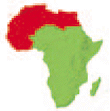DK People & Places: North & West Africa
The Sahara desert is vast and covers most of north and west Africa, stretching from the Atlantic Ocean in the west to the Red Sea in the east. Few people live in this desert area, which separates the Arab and Berber peoples of the north coast from the mainly Black African peoples to the south. Most of the 63 million Africans who inhabit this region live on the narrow coastal plain where the climate is milder.
During the 7th century AD, Arabs from the Arabian peninsula swept across north Africa, bringing their new religion of Islam with them. Today, most north and west Africans are Muslims, speak a common Arabic language, and share a culture based on the Islamic faith. Every town has at least one mosque, where the faithful are called to prayer.
Few people live in the Sahara because it regularly has temperatures of over 122°F (50°C) and water is very scarce. People such as the Tuareg have learned how to survive in these extreme conditions, and live by trading salt and other goods across huge distances. Camels are their transportation and also provide milk, meat, and hides. However, long droughts and other hardships have led many to give up desert life.
This is the name for the growth of the world’s deserts. It means that good farmland is turning into dry wasteland, which causes famine. It begins when expected rains fail to arrive in areas near the desert. Crops are still grown but the soil becomes infertile, and as the plants die, it turns to dust. With the Sahara spreading south, huge areas are under threat.
Most of the people of this region live on the land alongside the Mediterranean Sea and Atlantic Ocean. The climate here is warm and wet in winter and hot and dry in summer, which is better for farming than the desert interior. Many crops can be grown here, from citrus fruits and dates, to olives and tomatoes.
The colorful and busy souks (markets) of Morocco and Tunisia sell anything from traditional goods and handicrafts such as jewelry, leather, handwoven carpets, and embroidered clothes, to fresh meat, fish, vegetables, and household items. A souk is vital to the economy of a town, and is also a meeting place for workers, farmers, and traders coming in from the countryside.
The Nile, the world’s longest river, is an essential part of Egyptian life. When it floods in the summer, it brings vital water and rich mud from the highlands of Ethiopia and Sudan to its deserts, creating a fertile valley for crops. It also provides drinking water for those who live alongside it, and money from tourists who visit the many ancient sites along its banks.
Fez has hardly changed for centuries. Like all medieval Islamic cities, the old town of Fez was built according to rules laid down in the Qur’an, the holy book of Islam. The mosque is in the center, each religious and ethnic group has its own quarter, and the streets are narrow enough to give shade and wide enough for two fully laden camels to pass through.


